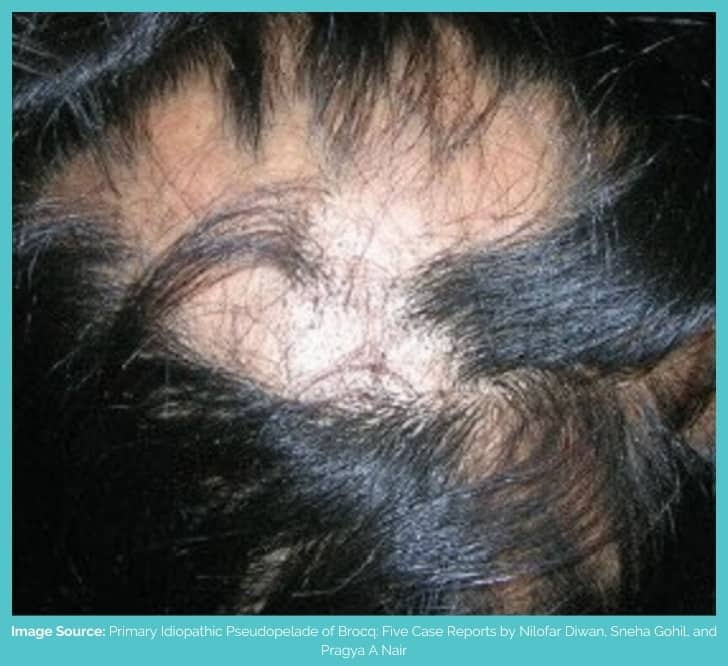Pseudopelade of Brocq (PPB) or Brocq’s alopecia is a rare hair disorder that results in scarring alopecia. It’s a chronic condition that usually progresses quite slowly and unpredictably.
While some consider it a separate condition, there are others who believe that the pseudopelade of Brocq is the end stage of other scarring alopecias like lichen planopilaris or lupus. However, there are many studies that prove otherwise.
Unfortunately, this condition can lead to the permanent destruction of hair follicles on the scalp. As a result, regrowth is not always possible. But there are some hair loss treatment options that can be considered.
In this guide, we’ll explore what is pseudopelade of Brocq and what you can do to manage it (since it is chronic).
What Is The Pseudopelade Of Brocq?
Pseudopelade of Brocq is a type of cicatricial alopecia. French dermatologist Louis-Anne-Jean Brocq named this type of hair loss in 1888 after noticing a similarity to alopecia areata.
“Pelade” comes from the word “pelage,” which refers to the woolly, furry or hairy coat of a mammal. However, in medicine, “pelade” also refers to alopecia areata. Since Brocq’s alopecia is not actually alopecia areata, it’s called the “pseudo-pelade” of Brocq.
As a standalone term, “pseudopelade” is used to describe other types of cicatricial alopecias with patches, according to DermNet. It can be slightly confusing, but it’s a good idea to keep the distinct terminologies (importantly, their meanings) in mind.
More commonly, this condition affects white women above the age of 40. However, it can also affect men and children, the latter being very rare.

Its appearance is described as being “footprints in the snow,” commonly affecting the parietal and crown (vertex) regions of the scalp. But it can spread to other areas and has even been reported in the beard region.
You should also keep in mind that this condition can come and go. There can be periods of active hair loss followed by periods of dormancy. And the progression of hair loss can be slow or fast and sudden. Although, it’s usually the former.
Types Of Pseudopelade Of Brocq
Because there’s some controversy around the status of pseudopelade of Brocq being a unique type of hair loss, it’s usually divided into two categories. These are as follows:
- Primary Pseudopelade – Characterised by permanent hair loss believed to be a result of immune problems that end up damaging the hair follicle stem cells.
- Secondary Pseudopelade – Refers to the “burnt-out” or “end-stage” inflammatory scarring alopecias (lichen planopilaris, lupus).
However, again, there are studies that show that Brocq’s alopecia is its own type of hair loss.
For instance, a study published in the Journal of Dermatological Science found genetic differences between lichen planopilaris and pseudopelade of Brocq.
Future research may help clear up the ambiguities.
What Are The Symptoms Of Pseudopelade Of Brocq?
Following are the signs and symptoms of Brocq’s alopecia:
- Small, irregularly-shaped hair loss patches
- Slightly depressed atrophic plaques on the skin
- Hair follicle scarring
- Soft, smooth skin
- Hypopigmentation
- Absence of sebaceous glands (that produce oil)
- No inflammation
- Slight itchiness
- Shiny scalp

There are some people who develop only one patch on their scalp. However, there are others who develop patches that engulf other areas of their scalp over time (lasting for years).
What Causes Pseudopelade Of Brocq?
The exact cause of the pseudopelade of Brocque isn’t known. However, there are different theories as to why it happens.
Some believe that it’s an autoimmune condition in which the body’s immune cells start attacking healthy cells.
As a result, the stem cells in the hair follicles are damaged. And without stem cells, it’s not possible to regrow new hair. That’s what leads to permanent alopecia.
Sebaceous glands present in the hair follicles are also thought to be involved. It’s believed that Brocq’s alopecia destroys these glands. And according to a study published in the Journal of Cutaneous Pathology, without sebaceous glands, the hair follicles are eventually destroyed.

Other than that, some researches indicate a genetic link. For instance, a case report in Clinical and Experimental Dermatology described a case in which two 7-year-old brothers developed this kind of hair loss. Potentially, another member of the family was also affected.
Lastly, Borrelia burgdorferi is also implicated. It’s the same bacterium that causes Lyme disease.
What Is The Treatment For Pseudopelade Of Brocq?
There’s no standardised treatment for the pseudopelade of Brocq. However, steroids (oral and injections), immunosuppressants, antimalarials, isotretinoin, minoxidil and antirejection medicine have been prescribed for its treatment. Unfortunately, however, these are not as effective in the treatment of this condition.
Still, a treatment plan may be developed depending on how severe your problem is. In a study published in Dermatologic Therapy, the researchers recommended that if less than 10% of the scalp is involved, topical and intralesional corticosteroids may help.
However, if the patient hasn’t responded to the treatment in 2-3 months or their lesions are large and aggressive, hydroxychloroquine alone or with prednisone may be of help. Once hydroxychloroquine takes effect, prednisone is tapered over a period of 2 months.
Even with treatment, there’s no guarantee that your condition will get better. And it won’t cure it either. But if Brocq lesions have stabilised, it is possible for you to undergo a hair transplant.
It’s only possible if the condition has been in remission for 1-2 years. And even as you get surgery, you should be aware of the risk that the pseudopelade of Brocq can come back.
Conclusion
Pseudopelade of Brocq can be a very distressing condition, especially because it is chronic and unpredictable. While this type of hair loss is usually seen at the back of the scalp, it can visibly affect other areas as well.
Unfortunately, the cause of this condition is not exactly understood. It’s not even known how Brocq’s alopecia occurs. It’s also often confused with lichen planopilaris. But still, there are some treatments that might be able to help you.
If you are experiencing abnormal hair loss, make sure to get in touch with a board-certified medical professional for an accurate diagnosis.
Reviewed and Approved by Trichologist Yaprak Yazan
FAQ
Is there a cure for the pseudopelade of Brocq?
Unfortunately, the pseudopelade of Brocq is a chronic condition, but it’s possible for it to go into remission.
Is there a pseudopelade of Brocq essential oils treatment?
According to DermNet, there’s no treatment that works for pseudopelade of Brocq. Prescribed drugs have also shown limited efficacy. So, essential oils are unlikely to work.


